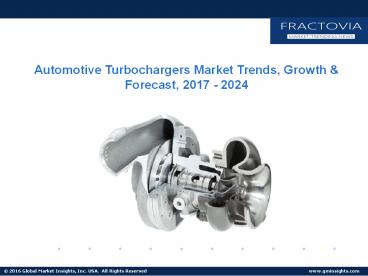Automotive Turbochargers Market Trends, Growth & Forecast, 2017 – 2024 - PowerPoint PPT Presentation
Title:
Automotive Turbochargers Market Trends, Growth & Forecast, 2017 – 2024
Description:
More Information @ Automotive turbocharger market from HCVs are expected to grow significantly, exhibiting over 7% CAGR from 2017 to 2024. – PowerPoint PPT presentation
Number of Views:97
Title: Automotive Turbochargers Market Trends, Growth & Forecast, 2017 – 2024
1
Automotive Turbochargers Market Trends, Growth
Forecast, 2017 - 2024
2
Key Insights from Automotive Turbochargers Market
- Given how effectively turbochargers enable
automobile manufacturers to use smaller engines
without compromising on the horsepower, major
automakers are turning to produce more models
with turbocharger engines, stimulating automotive
turbocharger market share. Cadillac launching its
twin-turbo V-8 engine in its CT6 V-Sport is a
recent instance validating the aforesaid fact. - Speaking along similar lines, it is prudent to
mention that automotive behemoth Porsche had also
recently brought forth the Turbo version of the
Panamera with 550 horsepower to automotive
turbocharger market. It is thus rather evident
that turbochargers would bring about a paradigm
shift in engine technology used in the automotive
industry. - Hailed as a potential competitor to the electric
vehicle sector, it would seem as if automotive
turbocharger market is here to stay, especially
considering its modest valuation of over USD 11
billion in 2016.
3
Continued...
- Environmental concerns have led to automotive
manufacturers striving to innovate novel methods
of trying to bring down CO2 levels caused by
automotive fumes. This has, on one hand, given
rise to a completely new breed of automobiles
the acclaimed EVs. On the other hand, internal
combustion engine vehicles have been increasingly
modified to weigh less and be more fuel
efficient. - As per statistics, turbochargers can raise fuel
efficiency by 45 - this alone has led to major
European automobile owners opting for this
component. A diesel engine fitted with a
turbocharger can apparently go 40 further and a
gasoline engine 20 further on a liter of fuel. - OEMs are renowned to use turbochargers for
creating some of the most fuel-efficient vehicles
across major geographies. For instance, the
turbocharger fitted 2011 Chevy Cruz of US
delivers a 42 mpg on the highway supposedly a
leading rating by the EPA. In Europe, the
turbocharged 2010 Volkswagen Polo held the
position for the most fuel-efficient car in the
world with worlds first turbo gasoline-electric
hybrid BMW X6 ActiveHybrid.
4
Latest Research Report On Automotive
Turbochargers Market _at_ https//www.fractovia.org/n
ews/industry-research-report/automotive-turbocharg
er-market Request for a sample of this
research report _at_ https//www.fractovia.org/reques
t-sample/884
5
U.S. Automotive Turbocharger Market, By System,
2016 2024, (Thousand Units)
6
Major Companies in Automotive Turbochargers
Market
- Honeywell
- Federal-Mogul
- BorgWarner
- Mitsubishi Heavy Industries
- Cummins Turbo Technologies
- Weifang Fuyuan
- Montupet
- IHI Corporation
7
Regional Insights in Automotive Turbochargers
Market
- Regionally, it would be prudent to mention that
emission laws have made a remarkable contribution
to the growth of the automotive turbocharger
market. Europe in particular, has evidenced a
rise in the stringency of emission laws, on
account of which Europe automotive turbocharger
market is expected to hold a dominant position
over 2017-2024. - Automotive turbocharger market has picked up
commendable pace in APAC in the recent years.
This growth can be attributed principally to the
proliferating demand for automobiles in countries
like China, India, Japan, and South Korea. Not to
mention, the fuel efficiency this technology
provides and the strict emission standards
enforced on automakers are also contributing
factors. For instance, the phase 4 passenger car
fuel consumption standard passed in China
mandates all passenger cars to increase fuel
efficiency and aims at reducing oil consumption
by 348 million barrels approximately. It also
intends to reduce carbon dioxide emissions by
about 149 million metric tons by 2030.
8
Stay In Touch Website www.gminsights.com Soci
al Media































